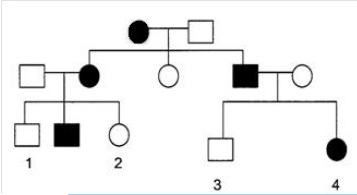Using a specific chemical, a cell biologist has blocked one type of channel-linked receptor in a lab rat's liver tissue. What was the likely mechanism of the chemical she used?
A. The chemical prohibits binding of a ligand to the receptor.
B. The chemical prohibits ions from entering the cell via active transport.
C. The chemical causes ions to move in the opposite direction of the ion gradient.
D. The chemical prohibits second messenger signaling.
A. The chemical prohibits binding of a ligand to the receptor.
You might also like to view...
In humans the pharyngeal slits mostly disappear during development, except for one pair that in the adults forms:
A. a cleft palate B. the Eustachian tubes C. the thyroid gland D. the glottis E. the opening to the voice box
Below is a pedigree of a human genetic disease in which solid color indicates affected individuals. Assume that the disease is caused by a gene that can have the alleles A or a. What is/are the possible genotype(s) of person 3?

A) AA
B) Aa
C) Either AA or Aa
D) aa
E) Cannot be determined
The radioactive decay of 14C produces
a. carbon 12. b. carbon 13. c. more carbon 14. d. nitrogen 14. e. oxygen 14.
Vessel elements differ from tracheids differ in that vessel elements contain pits
____________________ Indicate whether the statement is true or false.